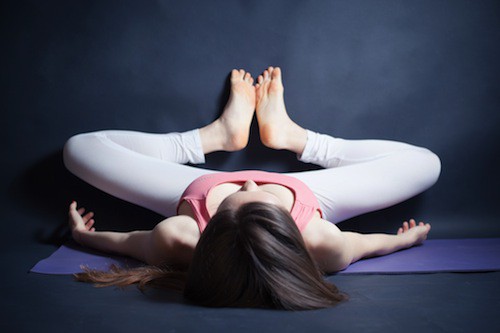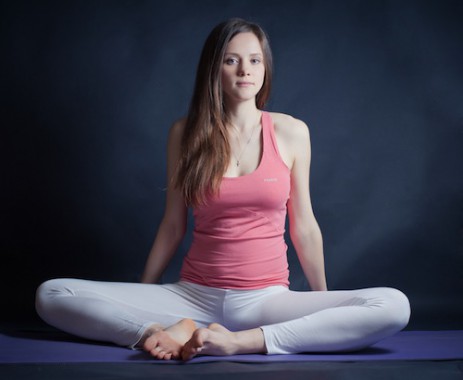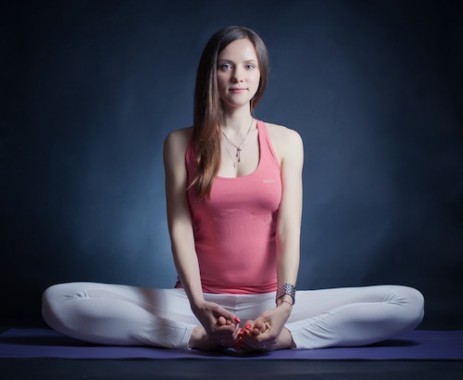Eduard Kushnir "Different Butterfly"
This article is about ways of mastering and proper alignment of Baddha Konasana or Butterfly Pose.
Eduard Kushnir teaches yoga in Kishinev (Moldova).
With endless gratitude to my teacher.
“In reality things are not as they seem”.
/Stanislaw Jerzy Lec/
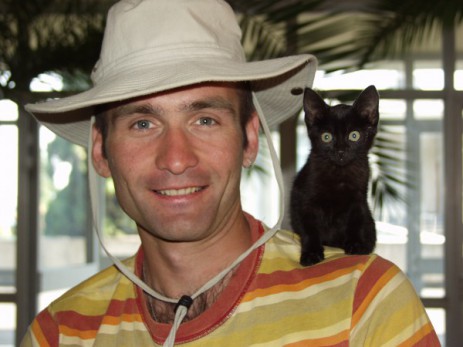
Before we touch the topic of the article I would like to say that (in principle, it is mentioned in any text of similar character) to fully benefit from the described techniques is only possible with a guidance of a competent teacher taking into consideration conditions fully covered in modern and ancient thematic literature.
Let’s turn to the subject now. While teaching we often face a phenomenon of surface perception of many practical moments. It happens due to certain reasons. Although it may seem strange today with this abundance of information around us, one of the reasons is difficulty to access a systematic and comprehensive objective knowledge. In its turn it leads to an attempt to fill in the lack of proper knowledge with some subjective conclusions. It lowers effectiveness of the practice, makes it useless or sometimes even dangerous. The idea of the presented material is in trying to study thoroughly such a relatively simple pose as Baddha Konasana or Butterfly.
The suggested methodology consists of three stages. Actually, the process goes fast enough. The key moment is to understand the concept of alignment, later it allows practicing this asana “right away” and fulfilling other asanas easily.
The easiest way to gain symmetry as a basic element of asana alignment concept is to try to inter-compensate impulses and tensions in the center. Physical center and the area there all tensions are being compensated often do not coincide. This process can be easily imagined in a form of a bicycle’s wheel with sixteen spokes, where all spokes are equally strained and symmetrically fixed to the axle. The axle of a wheel plays a role of a center where all tensions are inter-compensated which provides the symmetry of the construction in a whole. When spokes are not equally strained the center gets displaced and the construction looks like a “figure-of-eight”. Comparing with the human body a “figure-of-eight” can be a scoliosis, for example, but not obligatory.
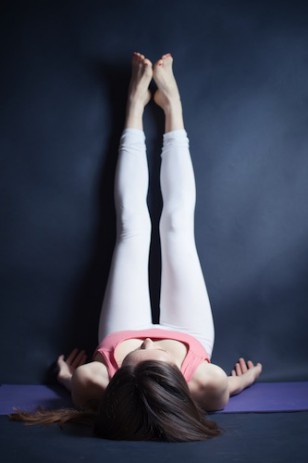
It is known that the center of a body is a navel area and its placement is not a difficult task - methodology is described in literature in detail. Practitioners are able to do it themselves very often, but as many have noticed the effect was short-term and instable. A more complex task that requires time and qualification is to settle the projection of the center which is based in the sacrum area. I should mention that it makes sense to start exactly from this.
Let’s understand how to do it in Baddha Konasana, on initial stage it is fulfilled in a lying position against the wall. It is recommended to everyone to pass this stage whatever experience, flexibility or force a practitioner has. The main advantage of doing it near the wall is a possibility to fix pelvis and give it coordinates linked to the wall and the floor. Lay down on your back and get your buttocks close to the wall.
Back is lying down on the floor and is relaxed, legs are straightened upwards, ischial bones are equally pressed against the wall.
When we bend legs in the knees putting them apart we may diagnose misalignment of the pelvis which is quite common it is also a cause of scoliosis. To be exact this misalignment (screw) of the pelvis is only a consequence of nonsymmetrical position of the legs. A human has a reflex to settle the symmetry based on the position of the legs, and if the pelvis is not fixed it is drawn away by the legs which are placed non-symmetrically.
Putting pelvis into a fixed position between the wall and the floor we allow asymmetry in the legs and keep the center. Distance between the crotch and the heels is defined individually in each case and it is easier to do in laying position. In a sitting position a practitioner creates tension in the lower back by trying to get his feet closer to himself. It opposes the overturning moment and creates an obstacle in stretching the back and spreading the impulse along the spine.
Let’s put the body into the position described and let’s generate an impulse from the center to the periphery. Here as a rule, some difficulties arise in explaining and correspondingly in understanding the sense of a process. Usually I use one trick: I suggest to push legs (not move but push creating a pushing moment) to the sides and to the floor (in laying position) or to the sides and backwards (in sitting position), straining middle gluteal and small gluteal muscles. Strictly speaking, these are only sensations. Deep muscles of the pelvis work here.
However, it is not that important, the task is to feel the place and process of the impulse being created, and at a later stage this pushing would not be needed. In a result in sacrum area you can feel warmth and pressure. In case of existing pathology some painful sensations may occur in this area, here it is better to consult with a specialist. If sensations of tension concentrate in the groin or the inner thigh then actions taken were wrong or the symmetry in pelvis position was not gained. Such practice would not give a proper result if there are sensations in hip joint combined with the pressure to the legs provided by the arms. It is recommended to provide pressure on the legs only if there are no any sensations in the legs or groin.
Then the second stage follows when all actions are fulfilled in sitting position with the back against the wall and pelvis fixed between the wall and the floor, keeping the symmetry shoulders and pelvis = a square in one plane.
Finally this asana should be done without help of the wall keeping the spine relaxed. Conclusive part of this stage would be an attempt to bend forward with a straight back. With the elbows pressed against the hips try to push with hands and stretch the spine between sacrum and shoulder blades. It should be noted that you should keep the impulse in sacrum area pushing legs with the help of gluteal muscles all the time we stay in asana, naturally, there are insignificant efforts needed to create this moment, it is accuracy that is important. The more accuracy the less effort is required, not more than is required for a light smile.
In bending forward it should be kept in mind that while working with the arms the impulse to the arms goes from the area of shoulder blades and the action itself is carried out by wide back muscles. Further, we generate the impulse from the center, navel area. To do it we should differentiate the lower part of the abdomen from the upper part (area between the navel and pubis) and try to make an active inhalation.
Ujjayi breathing is preferred, from the lower part of the abdomen a wave goes up to the chest, the chest itself is not actively involved it should be kept in a position allowing natural Uddiyana Bandha to take place. It is not a direct Uddiyana Bandha that we used to do. It looks like an indrawn abdomen as in down-faced-dog or bridge pose. It should be noted that presence of such Uddiyana Bandha (three bandhas in general) is a criteria of proper asana performance, many texts mention this effect. Unfortunately, it is extremely difficult to describe by words everything what concerns the work of the abdomen (navel) and breathing.
I suggest that practitioners try to master the method gradually or even separately from asana itself. For example, to understand a non-direct Uddiyana, i.e. to master the position of the chest required for a creation of this bandha, I recommend an exercise. Stand with your back against a corner of a wall, or just a wall. Sit down a little bit and try to level both areas of natural spinal lordosis, i.e. of the lower back and the neck. In result ribs get upwards, abdomen and jugular depression get inward, in navel area you can feel tension which is actually is followed by the impulse that I was describing earlier. Then this action can be carried out while sitting down in Baddha Konasana, then try to bend forward keeping the body configuration.
Summing up, I would like to say that there can be only one asana: the one your body stays in at present moment. Correspondingly, if you have the body it inevitably stays in one of the asanas. Hatha yoga systematizes positions of the bodies (physical as well as subtle bodies) and processes in them and brings them under certain laws. The process of self-discovery can be endlessly fascinating and I wish my readers to enjoy it at full extend.
Web-site: alteryoga.net






